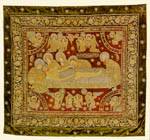|
|
| Church Embroidery |
1651/2 Vatopedi Monastery 184 x 166 cm Moldavian workshop |
|

|
The scene represented is the Lamentation. In the centre is the dead Christ, wrapped only in a loin-cloth and lying on the 'red rock, the length of a man', where he has been anointed with the mixture of myrrh and aloes. Inscribed on the arms of his cruciate halo is the phrase 'I am the Being'. Seated on the edge of the stone slab are the Virgin, left, cradling Christ's head in her lap while Joseph, right, holds his feet as he prepares to wind him in the clean linen cloth. John, sorrowful, bows over the body to kiss Christ's hand and beside him, weeping, are Mary Magdalene and Mary the mother of Joses. In the foreground, on a smaller scale than the principal figures, are four kneeling angels, two holding liturgical fans; these are also held by two of the four angels in the upper part of the composition. At the four corners are arcs framing the symbols of the Evangelists. The cosmic symbols of the sun and the moon, and the inscription: 'The Entombment' appear on the star-spangled ground. The small bands describing the four corner arcs are inscribed with the words of the Sanctus. The composition is framed by a double border, the outer with a broad floral guilloche, the inner bearing the following inscription: 'ΔΙΑ ΘΕΛΗΜΑΤΟC ΤΟΥ ΠΡΟΑΝΑΡΧΟΥ Π(Α)Τ(ΡΟ)C ΚΑΙ ΧΑΡΙΤΟC ΤΟΥ ΜΟΝΟΓΕΝΟΥC ΥΙΟΥ ΚΑΙ CΥΝΕΡΓΙΑC ΤΟΥ ΑΓΙΟΥ ΠΝ(ΕΥΜΑΤΟ)C ΗΒΟΥΛΗΘΗΝ/ΜΕΤΑ ΚΑΛΟΥ ΙΔΙΟΥ ΘΕΛΗΜΑΤΟC ΜΟΥ ΚΑΙ ΛΟΓΙCΜΟΥ ΚΡΙΤΩΝΟC ΕΓΩ Ο [ΙΩΑΝΝΗC] ΒΑCΙΛΕΙΟC ΒΩΙΒΟΝΔΑC/ΕΛΕΩ Θ(ΕΟ)Υ ΠΑCΗC ΜΟΛΔΟΒΛΑΧΙ(ΑC) CΥΝ ΤΗ CΥΜΒΙΑ ΜΟΙ ΔΟΜΝΑ ΑΙΚΑΤΕΡΙΝΗ ΤΟΥΤΟΝ ΤΟΝ ΕΠΙΤΑΦΙΟΝ ΕΟΠΗCΑΜΕΝ ΕΝ ΟΝΟΜΑΤΙ ΤΟΥ Κ(ΥΡΙΟ)Υ Κ(ΑΙ) Θ(ΕΟ)Υ Κ(ΑΙ) C(ΩΤΗ)Ρ(ΟC) ΗΜΩΝ Ι(ΗCΟ)Υ Χ(ΡΙCΤΟ)Υ ΚΑΙ ΑΦΙΕΡΩCΑΜΕΝ ΑΥΤΟΝ ΕΝ ΤΩ ΗΜΕΤΕΡΩ ΜΟΝΑCΤΗΡΙΩ ΤΗC Θ(ΕΟΤΟ)ΚΟΥ ΕΝ ΓΙΑCΙΩ ΓΙΜΩΜΕΝΟΝ ΤΗC ΑΝΑΛΥΨΕΩC. ΖΡΞ΄' (By the will of the Eternal Father and the grace of his only-begotten Son and with the help of the Holy Spirit, I, John Basil, by the grace of God Voevode of All Moldavia and Wallachia, of my own desire and good counsel and together with my wife the Lady Catherine did make this epitaphios in the name of our Lord and Saviour Jesus Christ, and did offer the same to our Monastery of the Theotokos in Jassy, commemorating the Ascension). The composition retains the zonal structure of earlier epitaphioi, such as that in the Monastery of the Transfiguration in the Megalo Meteoro (14th c.) or that of Alexander the Good, Prince of Moldavia (1428; Turdeanu 1941. Thιocharis 1977), while the iconography and the floral ornamention follow the 1638 epitaphios in the Church of the Three Hierarchs at Jassy, with the addition of the mourning figures, which transform its character from liturgical to narrative-historical. Stylistically, this work has neither the delicacy of the Jassy epitaphios nor its perfection of design, idealised features, inspired composition or harmonious palette of colours. The donor, Basil Lupus, was a distinguished prince of Moldavia. Although of Greek origin - his roots were in Thessaly, his education was Greek and he used a Greek signature -, he was deeply attached to the country over which he reigned. He seized the throne in the spring of 1643 and, after a few difficult years, succeeded in restoring peace in Moldavia. He founded Greek monasteries, restored direct relations with the Ecumenical Patriarchate, and in 1648 inaugurated the magnificent Church of the Three Hierarchs at Jassy, one of Romania's most splendid monuments. The Monastery of the Ascension referred to in the inscription is commonly known as the Golia Monastery, from the name of its founder, Anna Golia. The widow of Ion Golia, a former great logothetis of Moldavia (1572-80), she gave all her lands in Jassy to the monks of Mount Athos. The Monastery of the Ascension was bestowed upon the Vatopedi Monastery some time prior to January 20, 1606. Its monks were required to commemorate the name of their benefactress and to care for her if she should fall ill. Embroidered on red velvet, the epitaphios was at some point stitched to a newer backing. The work is in relief (padded), and executed in fine gold and silver wire, with silks used for the flesh. The wealth of gems decorating Christ's loincloth and the haloes imitates Byzantine models.
| |
|
Bibliography: Theochari 1996, pp. 424-7, fig. 358.
| ||
| M. Th. | ||
| Index of exhibits of Monastery of Vatopedi 17th century |
||
Reference address : https://www.elpenor.org/athos/en/e218ck22.asp